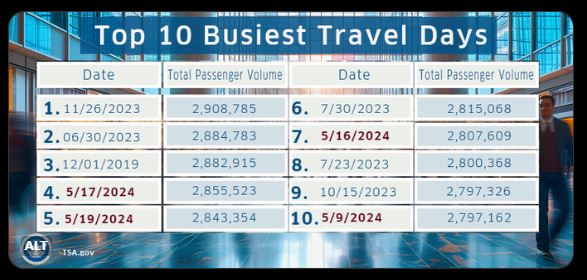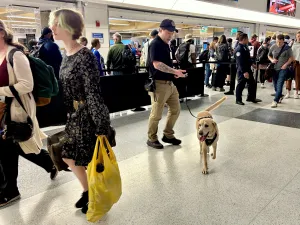
As Memorial Day Weekend approaches, the Transportation Security Administration (TSA) is prepared to handle an increase in the number of travelers who will be flying out of Washington Dulles International Airport and Ronald Reagan Washington National Airport.
For the first time ever, TSA will likely be screening more than 3 million passengers nationwide in a single day at some point this summer. We have already recorded four top 10 busiest days this month, with this Thursday and Friday before Memorial Day expected to see more than 2.9 individuals screened at checkpoints across the nation.
“At Dulles, we expect to provide security screening for anywhere from 39,000 passengers on our two busy days, Thursday and Friday, to 34,000 on the Sunday before Memorial Day. That is an average increase of 12% over 2023.” said Scott T. Johnson, TSA’s Federal Security Director for Dulles. “With the increase in air travel it’s important that passengers get to the airport early and come prepared to go through the checkpoint screening process efficiently. The Officers at TSA Dulles look forward to this Memorial Day weekend and to your safe travels.”
At Ronald Reagan Washington National Airport, TSA expects to screen approximately 8,000 more travelers per day for the holiday weekend than during an average weekend, explained John Busch, TSA’s Federal Security Director for the airport. That marks a 10 percent increase over 2023 checkpoint throughput. “We ask travelers to know the contents of their bags to ensure that they don’t have any prohibited items inside. This will help ensure a smooth passage through our checkpoints,” he said.
TSA continues to deploy new technologies at checkpoints to enhance security, which is why it is important for travelers to listen to and follow the guidance offered by TSA officers. TSA continues to upgrade all of its primary screening technologies for identity verification and carry-on bag screening. These critical technology investments improve security effectiveness; increase security efficiency; and enhance the passenger experience. These technologies include computed tomography (CT) and credential authentication technology (CAT or CAT-2). The CT units provide a 3D image of the contents of carry-on bags at checkpoints. The CAT units scan a traveler’s photo identification, confirm the traveler’s identity as well as their flight details. The new generation of CAT units, referred to as CAT-2, have the same capabilities, but are also equipped with a camera that captures a real-time photo of the traveler. CAT-2 compares the traveler’s photo on the ID against the in-person, real-time photo. Once the CAT-2 confirms the match, a security officer verifies and the traveler can proceed through the checkpoint, without ever exchanging a boarding pass. The photo is then deleted. Travelers who do not wish to participate in the facial matching process can opt out in favor of an alternative identity verification process.
TSA asks that the travelling public do their part in efficient checkpoint screening by arriving to the airport two hours prior to their scheduled flight departure and know what they can – and cannot pack – in their carry-on luggage.
TSA reminds passengers to always know the contents of their carry-on bag prior to coming to the security checkpoint. TSA has multiple resources available to passengers to help them determine whether an item is permitted in carry-on baggage, checked baggage, either or neither. Travelers can use the “Can I Bring?” feature on the TSA website or on the free downloadable myTSA app. Travelers can also tweet to @AskTSA or send a text message (275-872) if they have a travel question or are unsure if an item is allowed through security in a carry-on bag. Just snap a picture or send a question and get real-time assistance.
Individuals who are planning to travel this summer should consider enrolling in TSA PreCheck®. The popular expedited screening program allows travelers to leave on their shoes, jackets, belts and enables them to keep their electronics and 3-1-1 bags in their carry-on bags. Teenagers aged 13-17 may accompany their TSA PreCheck-enrolled parents or guardians through TSA PreCheck screening when traveling on the same reservation and when the TSA PreCheck indicator appears on the teen’s boarding pass. Children 12 and under may still accompany an enrolled parent or guardian when traveling through the TSA PreCheck lanes anytime without restriction.
This summer is also the ideal time to get a REAL ID drivers license. We are one year out from the REAL ID deadline. Beginning May 7, 2025, if you plan to use your state-issued ID or license to fly within the U.S., make sure it is REAL ID compliant.
Travelers should also keep these tips in mind while traveling:
- Do not attempt to bring a firearm through a TSA checkpoint; doing so compromises the safety and security of other passengers and our officers in the checkpoint. Passengers who do attempt to bring a firearm through a checkpoint can expect to receive a civil penalty (fines may be as high as $15,000) and lose eligibility for TSA PreCheck. Additionally, local law enforcement will be called and because these passengers may present additional risk beyond the firearm, they will receive enhanced screening.
- Get to the airport early. Travelers should arrive a minimum of two hours before their scheduled domestic flights and three hours before scheduled international flights. Roadways near airports are going to be crowded. It is going to take longer to locate an available parking space at the airport. Airline check-in counters will be busy. This is all before you even get to the security checkpoint.
If you find yourself waiting in a security checkpoint lane, use that time to your advantage. That’s the ideal time to remove items from your pockets and place them into a carry-on bag. It’s also the time to get out your ID and boarding pass so you’re not fumbling in your wallet for your ID when you step up to the TSA travel document checking podium. - Know before you go. Travelers need to know what can and cannot go in their carry-on bag, from firearms to oversize liquids. Passengers will spend more time in the security checkpoint if their carry-on items trigger an alarm because it results in TSA’s need to resolve the alarm by opening the carry-on bag to determine what triggered the alarm. Use TSA’s tools for your resources. TSA offers several ways for travelers to find out if an item is permitted in a carry-on bag, checked bag, either or neither and TSA has just launched a new higher level of assistance for travelers with questions about airport security screening procedures. Airline passengers may now send a text message using any mobile device to “AskTSA” (275-872). A virtual assistant is available 24 hours a day, 365 days a year. For more complicated questions, @AskTSA staff are available daily from 8 a.m. to 6 p.m. on Twitter and on Facebook Messenger.
The TSA web site has a feature on the homepage called “What can I bring?” Type in the name of the item and it will let you know if it should be packed in a checked bag or carry-on bag. The same handy feature is available on the free downloadable MyTSA app. The MyTSA app gives users 24/7 access to the most frequently requested airport security information on any mobile device, including a searchable database that will let you know whether an item can be packed in a carry-on bag, checked bag, either or neither. The app also identifies delay information and current weather conditions at your favorite airports nationwide. - Bring an acceptable ID.Before heading to the airport, travelers should make sure they have acceptable identification. And remember, the REAL ID deadline is less than a year away.
- Request passenger support.Travelers or families of passengers with disabilities and/or medical conditions may call the TSA Cares helpline toll free at 855-787-2227 at least 72 hours prior to travel with any questions about screening procedures and to find out what to expect at the security checkpoint. TSA Cares also arranges assistance at the checkpoint for travelers with specific needs.
- Never leave a suitcase, roller bag, laptop bag, shopping bag, backpack or any other item unattended. And if you come across an unattended item, please alert an airport official. If you See Something, Say Something®.

